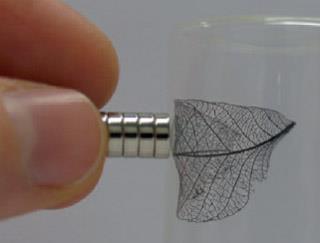Researchers create a magnetic leaf from iron carbide using a natural leaf as a template in a simple one-step process
A magnetic leaf has been created by researchers in Germany using a simple one-step process to synthesise a complex iron carbide microstructure that mimics the intricate structure of a leaf.
The team’s biotemplating method could be an easy and efficient way to enhance the functionality of metal carbides for catalytic and electrochemical applications.
Metal carbides are a desirable material, especially for use in electrodes and extreme catalytic processes, because of their resistance to high temperatures and mechanical stress. These properties, however, make it difficult to control their crystal growth and thus enhance their structures for optimal performance.
Now, Zoe Schnepp and colleagues at the Max Planck Institute of Colloids and Interfaces in Potsdam, Germany have used a biological templating technique to synthesise a highly complex iron carbide structure. ’Iron carbide in particular is quite challenging to synthesise, even as a powder, and so the fact that we’ve got such a complex microstructure is a really big advance,’ says Schnepp.
To make the iron carbide leaf, the team soaked a leaf skeleton in an iron acetate solution, which was then dried at 40?C in air and then heated under nitrogen to 700?C. During this process, the leaf skeleton (comprising lignin and cellulose) decomposes to a carbon-rich matrix and the iron acetate decomposes to iron oxide. Carbothermal reduction of the iron oxide by the carbon leaf matrix produces a porous iron carbide leaf replica.

Simon Hall, who investigates biotemplating as a way to create new materials at the University of Bristol, UK, thinks the work offers an ’elegant solution’ to the problems of making metal carbides. ’Most work of this nature is concerned with the growth of oxides, carbonates and phosphates, so it is exceptional that a carbide phase has been synthesised using a one-step biotemplated approach.’
’Metal carbides offer some really remarkable and unique properties like hardness or high magnetisation and so new approaches for the synthesis of these materials are very important,’ explains Schnepp. ’There are lots of properties of metal carbides which would be useful in a certain product shape, for example a high-surface area sponge or a thin film.’
Experiments with the iron carbide leaf revealed that it had magnetic and conductive properties suitable for water splitting and electrodeposition of platinum. However, although Schnepp says it’s possible the magnetic leaf could find some applications, the work is more important as demonstrating a general route to complex metal carbide structures.
’In theory any carbon-based structure could be used with this method. You could choose your original template to have the structural characteristics you want in your magnetic and conductive iron carbide product,’ she adds.
James Urquhart
References
et alAngew. Chem. Int. Ed., 2010, DOI: 10.1002/anie.201001626






No comments yet